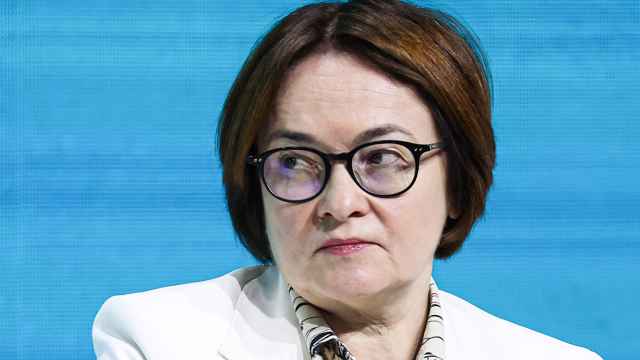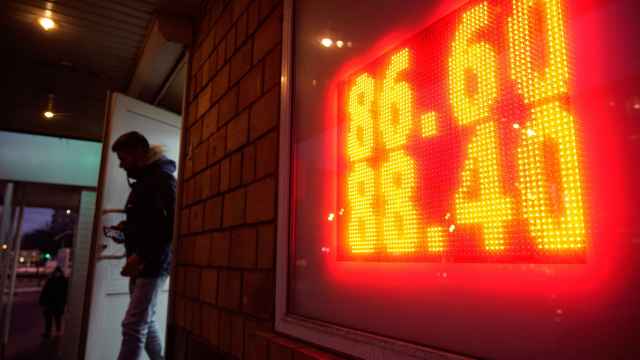The standoff between Russia and the West over Ukraine threatens to compromise Russia’s domestic economic plans and accentuate the country’s cost of living crisis — even if a diplomatic solution is eventually found — economists told The Moscow Times.
Russian markets have been hyper volatile in recent days as high-stakes talks between Russian and American officials continue Friday in Geneva in what could be a final salvo to avoid military escalation.
The Russian ruble has slid 10% since the end of October, when the confrontation first escalated — heaping more pressure on the country’s already tough battle against rising prices. Inflation is running at 8.4% according to the latest figures — its highest level in six years and more than double the Central Bank’s official 4% target.
Market volatility and the focus of the Kremlin’s attention on a potential military confrontation could push the country’s long-standing economic problems even further down the governing agenda, some experts warned.
“Russia’s increasingly assertive foreign policy represents a potential double setback for the economy by risking the imposition of additional sanctions while further neglecting long-standing socio-economic problems,” said Scope Ratings analyst Levon Kameryan in a research note published Thursday.
Central to those socio-economic problems is the living standards crisis that has beset the Russian economy in recent years.
Households have suffered almost a decade of falling real incomes — an era ushered in by Russian President Vladimir Putin’s turn toward austerity and conservative macroeconomic policies following sanctions levied at the Russian economy after the annexation of Crimea in 2014.
Since then, Russia has worked to sanctions-proof its economy, but has proved reluctant to spend its almost $200-billion sovereign wealth fund on supporting the economy or households — even in the depths of the coronavirus crisis in 2020 — believing that emptying the rainy day fund could leave Russia exposed to even heavier storms.
Attention is now turning to how the Central Bank is likely to approach the situation. In 2014, the regulator hiked rates to 17% as the Russian economy faced the double hit of Western sanctions in response to the annexation and a slump in world oil prices, resulting in a sharp devaluation of the ruble and surging inflation.
With the U.S. threatening a fresh round of sanctions if Moscow invades that could “devastate” the Russian economy, the bank is once again standing by.
“It’s a tough mix for the Central Bank,” Renaissance Capital economist Sofya Donets and former staffer at the regulator told The Moscow Times. “They’ve already communicated what they would do in the case of sanctions. The tricky thing is we’re not exactly in a sanctions scenario, but the ruble is already weak and uncertainty is high. That uncertainty is going to be the main thing that will influence the Central Bank.”
Analysts say the Central Bank, under influential Governor Elvira Nabiullina, a former economic minister and advisor to Putin who has been at the helm for nine years, has a hard-won reputation as a conservative regulator. It favors orthodox money management policies, such as positive real rates — a key rate that is higher than inflation.
Those principles are set to guide it in any response to a looming crisis. Any invasion would likely see the ruble crater further, and domestic inflation shoot up as a result of higher prices for imported goods.
However, the bank has all but ruled out a preemptive strike, experts say.
“The bank has been quite clear in the past about the risk of sanctions and foreign policy tensions. They’re only willing to act in response to facts — not risks or threats,” said ING Russia economist Dmitry Dolgin.
“Yes, the ruble has been under pressure so far, but it hasn’t been a catastrophic move. Clearly that’s not helping inflation, but it’s not yet dramatic enough to ensure a material acceleration in inflation,” he added.
Crisis expected
But even should no concrete sanctions materialize by the time of the regulator’s next meeting on Feb. 11, that uncertainty is already weighing on the Russian economy, and could force Nabiullina’s hand, some said.
“The ruble weakening on sanctions fears adds to inflation pressure, in turn increasing the risk of still more aggressive rate hikes,” said Christopher Granville of investment advisors T.S. Lombard.
“The rising exchange rate and overall market volatility do feed into the Central Bank’s decisions on the key rate — via its effects on inflation and inflation expectations,” added Dmitry Polevoy, investment director at brokerage Loko Invest.
Inflation expectations — a measure of how fast households and businesses expect prices to rise over the coming months — are one of the Central Bank’s most closely watched indicators.
“The Russian population and companies follow the ruble exchange rate as an important indicator of the economic and financial health of the country,” said Dolgin. “The pressure does not go unnoticed.”
More Russians believe the country could face an economic crisis in the near future than at any point since 2015 — when Russia was in the midst of recession and interest rates were hiked to 17% — a recent poll by the independent Levada Center found.
These dynamics could affect spending patterns and accentuate the possible inflation cycle which Nabiullna has repeatedly warned off. Even before the latest round of tensions, rising costs have proved more stubborn than the regulator and most economists first predicted, and markets expect inflation to come close to — if not above — 9% in the coming months.
For Donets, the volatility has not yet reached the kind of crisis levels that could trigger a serious rate hike — as much as two full percentage points if the U.S. does levy new sanctions against Russia — or other forms of intervention such as buying rubles to shore up the currency. But it is close.
“The ruble has not yet crossed the Central Bank’s red line. That line is for sure above 80 rubles to the dollar, maybe 80-plus,” she said.
The ruble was trading at around 76.7 on Friday morning.
“While the ruble is below 80, it’s okay. Above that is the point when we could see additional interventions.”
A Message from The Moscow Times:
Dear readers,
We are facing unprecedented challenges. Russia's Prosecutor General's Office has designated The Moscow Times as an "undesirable" organization, criminalizing our work and putting our staff at risk of prosecution. This follows our earlier unjust labeling as a "foreign agent."
These actions are direct attempts to silence independent journalism in Russia. The authorities claim our work "discredits the decisions of the Russian leadership." We see things differently: we strive to provide accurate, unbiased reporting on Russia.
We, the journalists of The Moscow Times, refuse to be silenced. But to continue our work, we need your help.
Your support, no matter how small, makes a world of difference. If you can, please support us monthly starting from just $2. It's quick to set up, and every contribution makes a significant impact.
By supporting The Moscow Times, you're defending open, independent journalism in the face of repression. Thank you for standing with us.
Remind me later.







